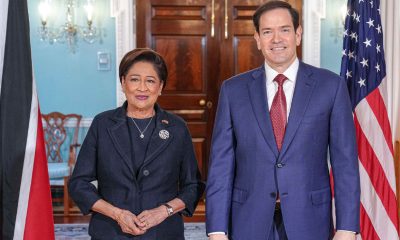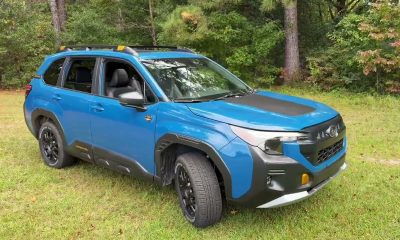Business
Lincoln Continental, the Car of Presidents, is Returning

A Lincoln Continental concept car is shown at the New York International Auto Show, Monday, March 30, 2015, in New York. Thirteen years after the last Continental rolled off the assembly line, Ford Motor Co. is resurrecting its storied nameplate. The production version of the full-size sedan goes on sale next year. (AP Photo/Mark Lennihan)
DEE-ANN DURBIN, AP Auto Writer
DEARBORN, Mich. (AP) — Elvis Presley had one; so did Clark Gable. It was even the sedan of presidents. Then the name vanished amid an invasion of newer luxury cars from Europe and Asia.
Now, the Lincoln Continental is back.
Thirteen years after the last Continental rolled off the assembly line, Ford Motor Co. is resurrecting its storied nameplate. The new Continental debuts in concept form at this week’s New York auto show. The production version of the full-size sedan goes on sale next year.
After more than a decade of toying with alphabetical names like LS and MKS to be more like its foreign rivals, Ford’s 98-year-old Lincoln brand is embracing its heritage. It’s a measure of the growing confidence at Lincoln, which is finally turning around a decades-long sales decline. And it’s a nod to the importance of China, where customers know the Continental name and appreciate brands with a rich history.
Ford CEO Mark Fields says the Continental always represented the best of Lincoln. Resurrecting it sets higher expectations, both within the company and outside of it.
“When we get a chance to work on an iconic nameplate like that, it’s a mixture of pride and a mixture of fear, because when you put that name out there, it’s got to deliver,” Fields told The Associated Press in a recent interview.
The Continental was born in 1938, when Henry Ford’s son Edsel commissioned a convertible he could use on his spring vacation. Thrilled by the reception he got as he drove the elegant sedan around Palm Beach, Edsel made the Continental part of Lincoln’s lineup.
The Continental soon became the pinnacle of American luxury. Warner Brothers gave Elizabeth Taylor a 1956 Continental with a custom paint color to match her eyes. A darker historical note: John F. Kennedy was riding in the back of a 1961 Continental convertible when he was assassinated in Dallas.
Continental sales peaked in 1990 at 62,732. But after that, Lincoln’s sales began slipping.
Ford had acquired other luxury brands such as Jaguar and Volvo. Lincoln’s designs got dull and failed to stand out from lower-priced Fords. The Continental was also squeezed by competition from the midsize Lincoln LS, which debuted in 2000, and the bigger Town Car.
Ford also underestimated the threat posed by German rivals, who were expanding their lineups, and newer Japanese luxury brands. By 2000, Lexus was the top-selling luxury brand in the U.S.; last year, BMW was.
To make its way back, Lincoln isn’t trying to be sporty like BMW or showy like Cadillac. Instead, Fields says, it wants to give drivers an experience that is elegant and serene.
“We want folks to get into our vehicles and — for lack of a better term — chill,” Fields said.
The strategy appears to be working. Lincoln’s U.S. sales rose 16 percent last year, making it one of the fastest-growing luxury brands in the market. The midsize MKZ was the brand’s top seller.
Full-size sedans like the Continental are a tough sell in the U.S., where buyers tend to prefer midsize sedans or SUVs. U.S. sales of Lincoln’s current full-size sedan, the MKS, fell 24 percent last year.
But globally, the segment is growing, Fields says. Ford has high hopes for the Lincoln brand in China, where it’s opening dazzling new dealerships complete with waterfalls. Ford began selling Lincolns in China late last year, and plans to open more than 20 dealerships there this year.
The concept car being unveiled Monday in New York is painted a deep Prussian blue, an homage to Continentals of the 1950s and 1960s. But there are few other references to its history.
Lincoln’s split-wing grille, a feature that dates to the 1940s, has been replaced by a tight, rectangular mesh grille, its shiny chrome patterned with tiny versions of Lincoln’s rectangular logo. The sides are smooth; even the door handles are hidden within a narrow strip of chrome at the beltline.
The concept is a technology showcase. The driver’s seat has a patented split cushion, so if the driver holds one leg out further than another, it will support each leg separately. The moonroof glass turns opaque with the touch of a button. Another button automatically moves the front passenger seat forward and fully reclines the rear passenger seat. That’s another nod to China, where luxury car owners often have their own drivers.
Under the hood is a 3-liter V6 EcoBoost engine that’s unique to Lincoln. Ford isn’t yet revealing more details, like whether the car is front- or rear-wheel drive. The Continental switched to a front-wheel-drive sedan in the 1980s, but many of its current competitors — the Infiniti Q70, Mercedes Benz S-Class and Lexus LS — are rear-wheel drive.
The Continental is expected to replace the seven-year-old MKS, which currently sits atop Lincoln’s car lineup.
Copyright 2015 The Associated Press. All rights reserved. This material may not be published, broadcast, rewritten or redistributed.
Activism
Oakland Post: Week of December 24 – 30, 2025
The printed Weekly Edition of the Oakland Post: Week of – December 24 – 30, 2025

To enlarge your view of this issue, use the slider, magnifying glass icon or full page icon in the lower right corner of the browser window.
Activism
Lu Lu’s House is Not Just Toying Around with the Community
Wilson and Lambert will be partnering with Mayor Barbara Lee on a toy giveaway on Dec. 20. Young people, like Dremont Wilkes, age 15, will help give away toys and encourage young people to stay in school and out of trouble. Wilkes wants to go to college and become a specialist in financial aid. Sports agent Aaron Goodwin has committed to giving all eight young people from Lu Lu’s House a fully paid free ride to college, provided they keep a 3.0 grade point average and continue the program. Lu Lu’s House is not toying around.

Special to the Post
Lu Lu’s House is a 501c3 organization based in Oakland, founded by Mr. Zirl Wilson and Mr. Tracy Lambert, both previously incarcerated. After their release from jail, they wanted to change things for the better in the community — and wow, have they done that!
The duo developed housing for previously incarcerated people, calling it “Lu Lu’s House,” after Wilson’s wonderful wife. At a time when many young people were robbing, looting, and involved in shootings, Wilson and Lambert took it upon themselves to risk their lives to engage young gang members and teach them about nonviolence, safety, cleanliness, business, education, and the importance of health and longevity.
Lambert sold hats and T-shirts at the Eastmont Mall and was visited by his friend Wilson. At the mall, they witnessed gangs of young people running into the stores, stealing whatever they could get their hands on and then rushing out. Wilson tried to stop them after numerous robberies and finally called the police, who Wilson said, “did not respond.” Having been incarcerated previously, they realized that if the young people were allowed to continue to rob the stores, they could receive multiple criminal counts, which would take their case from misdemeanors to felonies, resulting in incarceration.

Lu Lu’s House traveled to Los Angeles and obtained more than 500 toys
for a Dec. 20 giveaway in partnership with Oakland Mayor Barbara
Lee. Courtesy Oakland Private Industry,
Wilson took it upon himself to follow the young people home and when he arrived at their subsidized homes, he realized the importance of trying to save the young people from violence, drug addiction, lack of self-worth, and incarceration — as well as their families from losing subsidized housing. Lambert and Wilson explained to the young men and women, ages 13-17, that there were positive options which might allow them to make money legally and stay out of jail. Wilson and Lambert decided to teach them how to wash cars and they opened a car wash in East Oakland. Oakland’s Initiative, “Keep the town clean,” involved the young people from Lu Lu’s House participating in more than eight cleanup sessions throughout Oakland. To assist with their infrastructure, Lu Lu’s House has partnered with Oakland’s Private Industry Council.
For the Christmas season, Lu Lu’s House and reformed young people (who were previously robbed) will continue to give back.
Lu Lu’s House traveled to Los Angeles and obtained more than 500 toys.
Wilson and Lambert will be partnering with Mayor Barbara Lee on a toy giveaway on Dec. 20. Young people, like Dremont Wilkes, age 15, will help give away toys and encourage young people to stay in school and out of trouble. Wilkes wants to go to college and become a specialist in financial aid. Sports agent Aaron Goodwin has committed to giving all eight young people from Lu Lu’s House a fully paid free ride to college, provided they keep a 3.0 grade point average and continue the program. Lu Lu’s House is not toying around.
Activism
Desmond Gumbs — Visionary Founder, Mentor, and Builder of Opportunity
Gumbs’ coaching and leadership journey spans from Bishop O’Dowd High School, Oakland High School, Stellar Prep High School. Over the decades, hundreds of his students have gone on to college, earning academic and athletic scholarships and developing life skills that extend well beyond sports.

Special to the Post
For more than 25 years, Desmond Gumbs has been a cornerstone of Bay Area education and athletics — not simply as a coach, but as a mentor, founder, and architect of opportunity. While recent media narratives have focused narrowly on challenges, they fail to capture the far more important truth: Gumbs’ life’s work has been dedicated to building pathways to college, character, and long-term success for hundreds of young people.
A Career Defined by Impact
Gumbs’ coaching and leadership journey spans from Bishop O’Dowd High School, Oakland High School, Stellar Prep High School. Over the decades, hundreds of his students have gone on to college, earning academic and athletic scholarships and developing life skills that extend well beyond sports.
One of his most enduring contributions is his role as founder of Stellar Prep High School, a non-traditional, mission-driven institution created to serve students who needed additional structure, belief, and opportunity. Through Stellar Prep numerous students have advanced to college — many with scholarships — demonstrating Gumbs’ deep commitment to education as the foundation for athletic and personal success.

NCAA football history was made this year when Head Coach from
Mississippi Valley State, Terrell Buckley and Head Coach Desmond
Gumbs both had starting kickers that were women. This picture was
taken after the game.
A Personal Testament to the Mission: Addison Gumbs
Perhaps no example better reflects Desmond Gumbs’ philosophy than the journey of his son, Addison Gumbs. Addison became an Army All-American, one of the highest honors in high school football — and notably, the last Army All-Americans produced by the Bay Area, alongside Najee Harris.
Both young men went on to compete at the highest levels of college football — Addison Gumbs at the University of Oklahoma, and Najee Harris at the University of Alabama — representing the Bay Area on a national level.
Building Lincoln University Athletics From the Ground Up
In 2021, Gumbs accepted one of the most difficult challenges in college athletics: launching an entire athletics department at Lincoln University in Oakland from scratch. With no established infrastructure, limited facilities, and eventually the loss of key financial aid resources, he nonetheless built opportunities where none existed.
Under his leadership, Lincoln University introduced:
- Football
- Men’s and Women’s Basketball
- Men’s and Women’s Soccer
Operating as an independent program with no capital and no conference safety net, Gumbs was forced to innovate — finding ways to sustain teams, schedule competition, and keep student-athletes enrolled and progressing toward degrees. The work was never about comfort; it was about access.
Voices That Reflect His Impact
Desmond Gumbs’ philosophy has been consistently reflected in his own published words:
- “if you have an idea, you’re 75% there the remaining 25% is actually doing it.”
- “This generation doesn’t respect the title — they respect the person.”
- “Greatness is a habit, not a moment.”
Former players and community members have echoed similar sentiments in public commentary, crediting Gumbs with teaching them leadership, accountability, confidence, and belief in themselves — lessons that outlast any single season.
Context Matters More Than Headlines
Recent articles critical of Lincoln University athletics focus on logistical and financial hardships while ignoring the reality of building a new program with limited resources in one of the most expensive regions in the country. Such narratives are ultimately harmful and incomplete, failing to recognize the courage it takes to create opportunity instead of walking away when conditions are difficult.
The real story is not about early struggles — it is about vision, resilience, and service.
A Legacy That Endures
From founding Stellar PREP High School, to sending hundreds of students to college, to producing elite athletes like Addison Gumbs, to launching Lincoln University athletics, Desmond Gumbs’ legacy is one of belief in young people and relentless commitment to opportunity.
His work cannot be reduced to headlines or records. It lives on in degrees earned, scholarships secured, leaders developed, and futures changed — across the Bay Area and beyond.
-

 #NNPA BlackPress4 weeks ago
#NNPA BlackPress4 weeks agoLIHEAP Funds Released After Weeks of Delay as States and the District Rush to Protect Households from the Cold
-

 Alameda County4 weeks ago
Alameda County4 weeks agoSeth Curry Makes Impressive Debut with the Golden State Warriors
-

 #NNPA BlackPress4 weeks ago
#NNPA BlackPress4 weeks agoSeven Steps to Help Your Child Build Meaningful Connections
-

 #NNPA BlackPress4 weeks ago
#NNPA BlackPress4 weeks agoSeven Steps to Help Your Child Build Meaningful Connections
-

 #NNPA BlackPress4 weeks ago
#NNPA BlackPress4 weeks agoTrinidad and Tobago – Prime Minister Confirms U.S. Marines Working on Tobago Radar System
-

 #NNPA BlackPress4 weeks ago
#NNPA BlackPress4 weeks agoThanksgiving Celebrated Across the Tri-State
-

 #NNPA BlackPress4 weeks ago
#NNPA BlackPress4 weeks agoTeens Reject Today’s News as Trump Intensifies His Assault on the Press
-

 #NNPA BlackPress4 weeks ago
#NNPA BlackPress4 weeks agoBreaking the Silence: Black Veterans Speak Out on PTSD and the Path to Recovery





















































